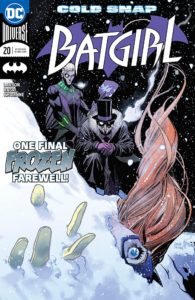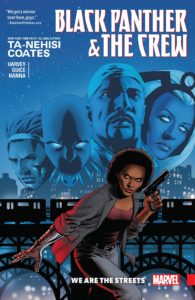
Superheroes Fight Gentrification!
Article by Jim Allegro
Mainstream comics have recently joined the ranks of those concerned for the colonization of American cities. The displacement from urban spaces of lower-income families by young rich professionals has emerged as a steady theme of street-level comics such as Batgirl, Black Panther, and Ms. Marvel. These comic books share a commitment to identifying the agents of urban capitalism, whether greedy real estate developers, complicit city officials, or callous hipsters, but they could not be more different in their use of superheroes to interpret this problem. The enlistment of crusading crime fighters to fight gentrification reflects the same fissures of race and class that sustain and complicate the problem itself.
Gentrifiers against Gentrification
Barbara Gordon’s struggle to identify and combat the effects of urban displacement is a unifying theme of DC’s Rebirth edition of Batgirl. Hope Larson’s character fights in several arcs to bring attention to the homeless among the clueless intelligentsia of her Burnside neighborhood. In the present arc, Cold Snap, she defeats the illegal tactics of a rival donut  shop seeking to displace a local competitor and she teams up with Penguin to confront an ex-boyfriend-tech mogul who unleashes a snow storm on Burnside.
shop seeking to displace a local competitor and she teams up with Penguin to confront an ex-boyfriend-tech mogul who unleashes a snow storm on Burnside.
The problem with Gordon’s efforts is that she is herself a gentrifier. Batgirl reflects the vantage of the privileged, proffering as a solution a wealthy white patron who lives among the working class people of color she purports to protect. The result simplifies urban life, catering its commentary to an audience receptive to progressive issues such as global warming but disinterested in the dirty politics of city life, perhaps a bit like some actual gentrifiers. Larson chooses camp over reality by having the Holey Moley doughnut shop send three actors dressed as goons to threaten a local rival. Gordon’s carping in an earlier issue about the loss of a coffee bar to gentrification is funny in an ironic, hipster way, but also hints at complacency, the substitution of paradox for genuine anger at the very real effects of urban renewal.
Self-Determination in the Streets
On the other end of the spectrum is Ta-nihisi Coates’ 2017 iteration of Marvel’s Black Panther & the Crew. Some members of the superhero team of T’Challa, Luke Cage, Misty Knight, Manifold, and storm are native to the comic’s Harlem setting. They stand in for those who suffer most from gentrification in this story about people of color banding  together to fight corruption and inequality on their own terms. There is nothing campy about the realistic nature of this complex plot, which turns on tensions among Harlem residents and the police after a civil rights activist, Ezra Miller, inexplicably dies in police custody.
together to fight corruption and inequality on their own terms. There is nothing campy about the realistic nature of this complex plot, which turns on tensions among Harlem residents and the police after a civil rights activist, Ezra Miller, inexplicably dies in police custody.
We are not sure what Coates had in store for this comic, since Marvel abruptly canceled his run after six issues. What we do know is that he intended for it to be unsparing in its criticism of those who benefit most from urban displacement. He calls out the hypocrisy of concerned white liberals in issue #3 with the figure of a white realtor who tries his best to claim street credibility on the grounds that he once took an African-American studies class. From him, T’Challa and Storm still learn more about the politics of ‘cleaning up’ a poor black neighborhood than Barbara Gordon glimpses during her time in Burnside.
Urban Diversity as a Symbol
Ms. Marvel occupies a mid-way point between these interpretations. Kamala Khan is of the place that she seeks to protect, the child of Pakistani Muslim immigrants who take up residence in multicultural Jersey City. Her nemesis, HYDRA, is the sinister, if cartoonish, force behind urban renewal. Posing as a developer, HYDRA tries to control Jersey City by ‘ridding’ it of crime in the first arc of G. Willow Wilson’s comic, and, in last fall’s Mecca storyline, they try to isolate Inhumans from other residents of the city.

Both arcs reference Khan’s background to make a symbolic point about diversity. In the first arc, HYDRA enlists Khan’s image without permission to promote their ‘clean-up’ campaign, in effect citing diversity as a reason to gentrify, much as actual realtors cite ‘ethnic’ culture to inspire white professionals to infiltrate a city block. By depicting Inhumans such as Kahn are a threat, Mecca shows us what happens after whites move in, when diversity becomes a liability in need of containing. Willow’s subtle reading of gentrification, then, joins Coates and Larson in reminding us that superheroes can be symbols of our own apprehensions and pretensions about the social and racial transformation in the American city.

![[REVIEW] X-23: DEADLY REGENESIS #1](https://geekd-out.com/wp-content/uploads/2023/03/x23-dr-1-feat-150x150.jpg)

